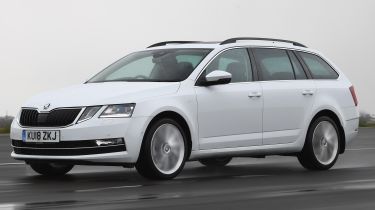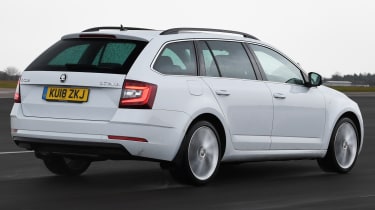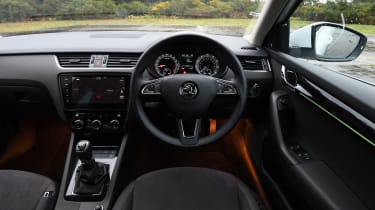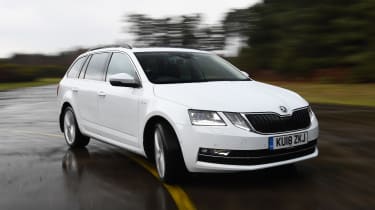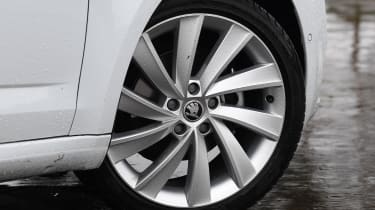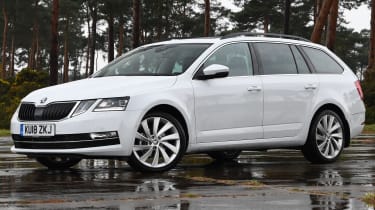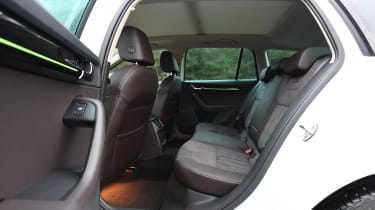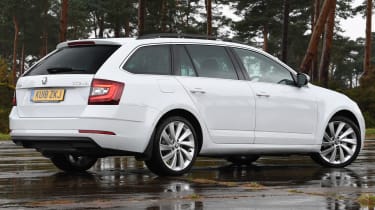Skoda Octavia Estate (2013 - 2020) review
The Skoda Octavia Estate has been updated, but it still offers huge value for money and space

The Skoda Octavia Estate has been the practical wagon of choice for families ever since Volvo's estate cars abandoned ultimate load carrying in the pursuit of style. The Octavia Mk1 arrived in 1998, and it set the template for the two generations that followed in terms of practicality, space, reliability and relatively low cost.
Today, the Mk3 Octavia Estate is a great choice for space and practicality, but it also manages to do it with a bit of style. The car's lines are neat and defined rather than elegant, but there's a no-nonsense charm about the way it looks; and, with a facelift in 2017 adding split headlights, they do at least add something of a talking point to the front of the car.
For all that, the main focus is the Octavia Estate's space inside. While the car is based on the same running gear as the VW Golf, that longer rear end means there's 610 litres of space in five-seat mode, and 1,740 litres available with the back seats folded down. That's ahead of the Golf Estate, which has 605 litres and 1,620 litres respectively.
The Octavia Estate range mirrors that of the Octavia hatch, and goes from basic workhorse to luxury and performance versions. At the start of the range is the S, while the SE and SE Technology models are priced at the same level. SE L is the equivalent of the older Elegance trim, so it's pretty well equipped, while at the top of the range there are a choice of different models, depending on what you want from a high-spec machine. For buyers wanting luxury, there's Laurin and Klement (or L&K) trim, while the vRS uses the same 2.0 TSI turbo petrol engine as the VW Golf GTI. if you want something a little different, the Octavia Scout offers a decent amount of luxury, plus a raised ride height, off-road style body cladding and four-wheel drive.
Used - available now

2024 Skoda
Octavia
11,403 milesManualPetrol1.5L
Cash £17,299
2024 Skoda
Octavia
38,764 milesManualPetrol1.5L
Cash £15,699
2020 Skoda
Octavia
35,537 milesAutomaticPetrol1.5L
Cash £12,749
2020 Skoda
Octavia
48,158 milesManualPetrol1.5L
Cash £13,100The recent facelift saw the engine range revised to incorporate the VW Group's latest petrol and diesel engines. There are four turbocharged petrol engines available: a 113bhp 1.0 TSI 115PS three-cylinder, the 148bhp 1.4 TSI 150PS, the 148bhp 1.5 EcoTSI with fuel-saving cylinder deactivation and the 2.0 TSI in 230PS (227bhp) and 245PS (242bhp) guises, although the latter is only available in the vRS.
Diesel power comprises the 113bhp 1.6 TDI 115PS, 148bhp 2.0 TDI 150PS and 181bhp 2.0 TDI 184PS. Again, that last engine is only available at the top of the range in the vRS and the Scout. All engines can be had with Skoda's sharp-shifting DSG auto gearbox, while 4x4 is standard on the Octavia Scout, and can be added to the 2.0 TDI 150 SE L and Laurin and Klement or the vRS diesel.
The original Skoda Octavia was one of the first products from the Czech firm to benefit from VW's takeover. It used the same platform as the VW Golf Mk4 and Audi A3, and this parts-sharing tradition has continued to this day. That means the current Octavia is more sprightly to drive than its slightly restrained looks suggest, and simply adds another level of talent to this great all-rounder.
Rivals for the Octavia Estate include the closely related SEAT Leon ST and VW Golf Estate, while the Peugeot 308 SW is the car in this class with the biggest boot, although rear legroom is sacrificed for it. Elsewhere, the Renault Megane Sport Tourer, Vauxhall Astra Sports Tourer, Kia Cee'd Sportswagon, Hyundai i30 Tourer and Toyota Auris Touring Sports are all estates with fancy names, but not as much space as the Octavia. Another perennial is the Ford Focus Estate, while the Fiat Tipo Station Wagon is a budget option and the Subaru Levorg Sport Tourer is a sporty leftfield choice for those that don't want to stick to estate car convention.
Long gone is the era of Skoda jokes: the Octavia Estate is a class-leading family estate. It blends the mechanicals of the VW Golf with lower prices and a more practical bodystyle that's befitting of an estate car - it's arguably better looking than the regular Octavia hatch. It makes it a cavernous load-lugger, too, and is ideal for families, wallet-conscious fleet buyers and, if you choose the GTI-baiting vRS, even hot hatch fans. 2017's update added a new look and more interior tech, too.
• Best estate cars to buy right now
The estate has 610 litres of space with the rear seats in place and a gargantuan 1,740 litres with the bench folded, so the Octavia is big enough to embarrass cars from the class above such as the BMW 3 Series Touring and Audi A4 Avant. Yet its Germanic cabin, while rather dour and uninspiring, is solidly put together and feels more expensive and refined inside than rivals such as the Ford Focus Estate and Vauxhall Astra Tourer. You can identify the shared switchgear from the VW Golf Estate and SEAT Leon ST, but you should choose the Skoda if outright load carrying volume is your biggest concern.
Engines, performance and drive
While there have been some changes inside and out, the Octavia feels remarkably similar to its predecessor on the move. That’s no bad thing – the Skoda is a capable family car that effortlessly mixes decent performance with strong economy.
As with other cars in the MQB family, the Octavia benefits from crisp and composed handling, even in the most basic models. The steering is naturally weighted, there’s bags of grip, and body control is excellent – meaning you can carry speed through corners with confidence.
There’s a six-speed manual or DSG gearbox available on the Octavia Estate. The gear change itself is very smooth but opt for the automatic and you’ll sacrifice a little when it comes to economy. It's also too sluggish to kick down when you demand a squirt of quick acceleration, so the new seven-speed versions on other VW products perform better.
The Octavia comes with a Driver Profile system, which adjusts engine and steering response according to which mode you’ve selected (Eco, Normal, Sport or Individual). Yet it doesn’t get a front differential, which means it's not really eager to turn in. Normal mode remains the only worthwhile choice, as Eco makes the throttle response too lazy and Sport spoils the normally fluid steering with extra weighting. In its default mode, the naturally weighted steering, decent grip and strong brakes give the Skoda composed and confidence-inspiring handling.
All-wheel drive is available on certain models, handy for those who’ll be tackling tougher terrain more frequently. Under normal driving conditions the 4x4 model is driven only by the front wheels but when the car detects it is struggling for grip, the rear wheels come in to play. The transition from front to all-wheel drive is seamless even when faced with the worst of British weather.
Like all Skodas, the ride in the Octavia estate is very impressive. It can be a little firm when driving around town but like its rivals from Honda, VW and SEAT, the ride softens at higher speeds.
Engines
The Octavia Estate has four turbocharged petrol engines to choose from, and the 2017 update saw them revised for the first time. At the entry point of the range is the 113bhp 1.0 TSI 115 three-cylinder unit. Don't be put off by its modest capacity, because it's capable of 0-62mph in 10.1 seconds and a 124mph maximum, which are better figures than the 1.2 TSI it replaced. It also has 200Nm of torque, although it might not be at its best when towing a caravan.
Next up is the 1.4 TSI 150 which has 148bhp and does 0-62mph in 8.2 seconds with a 134mph maximum. The 1.8 TSI was dropped at the 2017 facelift, and Skoda introduced another 148bhp motor, this time the latest 1.5 TSI from the VW Group. This is called EcoTSI elsewhere in the company, and it features cylinder deactivation to boost economy. It has the same 148bhp and 250Nm outputs as the 1.4, but the clever cylinder shut-off helps it return 56.5mpg, compared to 53.3mpg for the 1.4.
Overall, it represents a compelling package for family motoring – punchy and making the most of the generous torque on offer to deliver reliable and linear performance. That means it’s well suited to overtaking and motorway driving. It's impressively refined, too, as well as being hooked up to a snappy six-speed manual gearbox.
The performance range-topper is the 2.0 TSI which comes in 230PS or 245PS guises. These have 227bhp and 242bhp respectively and are only offered in the fast vRS estate. The performance differential between the two is marginal – 0-62mph in 6.8 or 6.7 seconds, and a top speed of 152 or 153mph. If you pick the DSG gearbox you’ll lose a few tenths.
Diesel options kick off with a 1.6 TDI that was updated in 2017 to now make 113bhp. It manages 0-62mph in 10.2 seconds and 125mph. The 250Nm torque output is the same as before, and so is the TDI's familiar clattery idle. Try to accelerate in a high gear from low revs and it gets uncomfortably boomy, but beyond 1,800rpm it smooths out.
When we tested the Octavia Estate 1.6 TDI, its relatively low kerbweight helped it set the pace during our 0-60mph sprint, needing a respectable 10.0 seconds, which was nine-tenths up on a Renault Megane Sport Tourer. And while it couldn’t match the six-speed Renault during our in-gear tests, it had the measure of a Golf Estate using the same engine in third, fourth and fifth gears.
In the real world, the Skoda feels brisk enough, and has no problem keeping up with faster-moving traffic. Peak torque is delivered at just 1,500rpm, and combines with the well-chosen gear ratios and snappy shift action to make it easy to keep the engine on the boil.
Further up the diesel range, the 2.0 TDI 150 comes with 148bhp and is offered on the mainstream specs.or 182bhp. it delivers 0-62mph in 8.5 seconds with a 134mph maximum. If you want a faster diesel, the 2.0 TDI 184 has 182bhp and only comes in the vRS or Scout, the latter with the DSG gearbox only. Fitted to the vRS it manages 0-62mph in 8.0 seconds and 143mph.
MPG, CO2 and Running Costs
Compared to the Golf and Leon estates, the Octavia offers better value for money. The Skoda comes with more equipment, including climate control, voice-activated Bluetooth and rear parking sensors – adding just the latter two items bumps up the Golf’s price by around £1,000.
If you need the advantage of four-wheel drive (not available in the VW Golf Estate, or any rival this side of an Audi or Subaru), Skoda will charge you about £1,500.
Both the Octavia and the Golf have a decent range of options, although the Skoda manages to lead the VW once again here, as its extras are slightly cheaper.
The automatic models all have identical tax costs, but the manual Octavia 1.6 TDI emits 106g/km of CO2 and it is capable of a claimed 68.9mpg on the combined test cycle.
The petrols are pretty efficient too, and even the 230bhp vRS has a claimed combined figure of 46.3mpg – but it does have a higher CO2 rating of 149g/km.��
Insurance groups
Insurance groups for the Octavia Estate range from 14 for the entry S model, and rise to 29 for the sportiest petrol vRS. The 2.0-litre diesel models are group 20, while the flagship Laurin & Klement trim is up to group 25.
Depreciation
The Octavia Estate’s solid reputation and obvious practical qualities mean it’s quite in demand on the used market, so it'll hold onto its value reasonably well. Our experts reckon you can expect to retain up to 45 per cent of an Octavia’s value after three years, whereas a rival from Ford or Vauxhall would likely dip below 40 per cent.
The 1.0 TSI petrol is likely to perform less well than the frugal diesels in percentage terms, but it’s a couple of grand cheaper up front.
Interior, design and technology
Like the company’s larger Superb, the Octavia looks better as an estate than as a hatchback. But the combination of right angles and straight edges means it’s handsome rather than pretty. While it's not as eye-catching as the SEAT Leon ST, the well-proportioned Skoda has plenty of upmarket appeal, even in mid-range SE specification.
However, that front end styling, with headlights that are now bisected by the bodywork, and a more prominent 'beak' on the leading edge of the bonnet, might not be to everyone's tastes. Still, find a colour that hides or accentuates the new looks, and you should be able to live with it, especially as it doesn't have an effect on the car's practicality.
Most attractive is the range-topping Laurin & Klement version, named after Skoda's 19th-century founders. Fitted as standard are bi-xenon headlights, LED rear lights and 18-inch wheels, adding a dash of sophisticated aggression to the plain Octavia Estate shape.
Surprisingly, the Octavia Estate is exactly the same length as the hatch, but the estate-car styling means the long rear overhang doesn’t look as awkward as it does on the five-door. The only other difference between hatch and estate is the addition of black roof rails – although you can upgrade them to silver for £150.
The SE model comes with 16-inch alloy wheels, which seem a little lost in the arches. The optional 18-inch wheels are smarter.
Inside, the Octavia is pretty solid, but unspectacular. There’s plenty of dark grey plastic trim, yet it’s lifted a little by the gloss-black finish surrounding the radio, and extra silver trim around the gearlever and doors. In order to maintain the VW Group pecking order, materials aren't quite up to the plush nature of the VW Golf's.
Sat-nav, stereo and infotainment
As part of its facelift in 2017, the Octavia gained a new infotainment system – essentially a reskin of the unit that made its debut as part of the Golf facelift earlier on in 2017. All Octavias get an eight-inch touchscreen as standard. The entry-level Bolero is fitted to S and SE models and features DAB and Bluetooth, plus Apple CarPlay and Android Auto smartphone connectivity. It’s easy to use, with slick graphics and a logical menu system, while the smartphone apps mean you can use your mobile's mapping data rather than having to upgrade to a factory-fit sat-nav.
SE Technology models and above benefit from the Amundsen unit, which uses the same clean interface as Bolero but does feature 3D sat-nav. Also included is a year’s subscription to Skoda Connect, which gives you remote access to several functions, plus automatic emergency notification in the event of an accident. For around £400 the Infotainment Online adds apps, including Google Earth and parking services.
Flagship L&K models get the 9.2-inch Columbus system (it's a £1,050 option on SE Tech and SE L models), among other extras. All models with nav can add a WiFi hotspot for £550 and wireless charging for £300.
Practicality, comfort and boot space
Thanks to a straightforward dashboard and good ergonomics, the Octavia Estate is easy and uncomplicated to drive. There’s plenty of adjustment in both the steering wheel and driver’s seat, and with good leg and headroom, it’s easy to get comfortable.
Once on the move, you’ll be glad of the car’s good all-round visibility, although optional parking sensors and a reversing camera will help if you add them to your spec list.
Around the Octavia’s cabin, you’ll find plenty of useful storage, including an air-conditioned glovebox, deep door bins and a handy cubby in front of the gearlever. Of course, the ice scraper mounted in the fuel filler flap is still present and correct, while a slotted smartphone holder is designed to sit in one of the cup-holders. Skoda's Simply Clever options boost the car's versatility further. There’s a £55 load bay net for holding loose items, and a neat £85 double-sided, wipe-clean boot floor, too.
Size
At 4,658mm overall the Octavia Estate is longer than all of its compact hatch-based estate rivals, but some way short of the Ford Mondeo Estate, which the Skoda beats for interior space.
Leg room, head room & passenger space
Overall, the Octavia Estate offers more passenger space than the Ford Mondeo, so accommodating five people should present no problems apart from a relative lack of foot space for the central rear passenger. (Although most models are front-wheel-drive, 4x4 models require a transmission tunnel.)
In the back, there’s a folding centre armrest with a pair of cup-holders. Better still, rear passengers get loads of headroom and legroom.
Boot
The Octavia no longer leads the way for boot space in this class. The Peugeot 308 SW now wears that crown, although the Octavia’s 610-litre capacity will be more than enough for most buyers.
Fold the 60:40 split rear bench and the space increases to 1,740 litres – which is still a little behind the Peugeot's 1,775 litres. The Ford Mondeo has 537 litres, or 1,728 litres with the seats folded.
The Octavia has a step in the floor behind the seats, so you don’t get a totally flat load area. For £150, you can add an optional variable load floor, which removes any obstacles and creates handy underfloor storage. The load bay is also packed with useful hooks and cubbies, seatback release levers and a 12V socket. However, we find it very stingy that Skoda asks an extra £55 for a luggage net, even on high-spec models.
Reliability and Safety
The Skoda Octavia is a relatively new car, but there should be no concerns about its long-term durability. Its platform forms the basis of many VW Group cars, while the 1.6-litre TDI engine is tried and tested.
You also get excellent dealer back-up from Skoda – the brand consistently impresses in our Driver Power satisfaction surveys.
Getting down to specifics, the latest-generation Octavia itself earned itself a decent 21st place finish out of 75 cars in the 2017 reliability category. While that's a good result in itself, it was actually the poorest-performing Skoda in the survey, with the Superb and Yeti placing first and second, and the latest Fabia in 11th.
Meanwhile, on the safety front, Euro NCAP awarded the Octavia hatchback a five-star crash-test rating in 2013. While the estate model hasn’t been independently tested, we’d expect any future results to be broadly similar.
Euro NCAP awarded it a very reassuring 93 per cent rating for adult occupant protection, with a good 86 per cent for child occupants and 66 per cent for pedestrians. The latter score was downgraded because the Octavia was initially tested with an active bonnet that moved upwards to provide a crumple-zone effect for pedestrians – but Skoda hasn’t made the technology available.
The Octavia’s standard safety kit includes post-collision braking, which will automatically apply the brakes after a crash to stop the car moving in the event of a secondary impact. Driver fatigue and tyre-pressure monitors feature, too, while other options include lane assist, and crew assist. The latter senses when a collision seems inevitable and closes the windows and sunroof, as well as tightening the seatbelts.
It's worth noting that the Octavia's Euro NCAP score can't be compared directly with more recent models, as the NCAP test was made tougher in 2016 and adjusted to account for the availability of optional safety equipment.
Warranty
You might think that, given the brand’s decent reliability reputation, Skoda’s marketing types could come up with a warranty that improves the current offer. Three years and 60,000 miles used to be an industry standard, but with five- and seven-year deals on offer from Hyundai and Kia, and others offering much bigger mileage caps, the Skoda warranty is starting to look a bit miserly.
Servicing
Skoda servicing is competitive with other mainstream rivals, and the firm offers a range of service and maintenance plans so you can spread the cost monthly.
Service plans cover just the scheduled checks, while maintenance plans also include any necessary repairs to cooling and electrical systems, plus engine, suspension and transmission repairs – with certain exceptions – up to a maximum of 120,000 miles. (Including many of the things that would otherwise be covered by a longer standard warranty term.)

